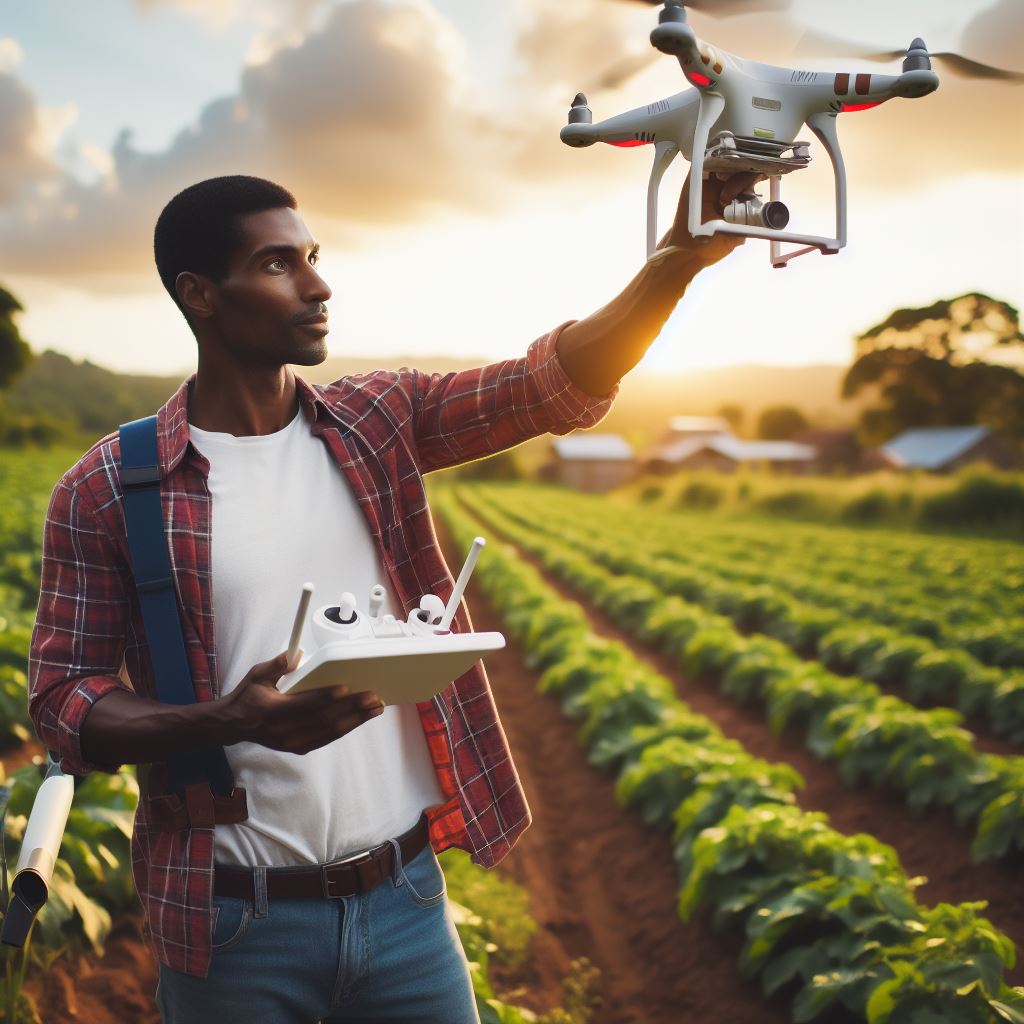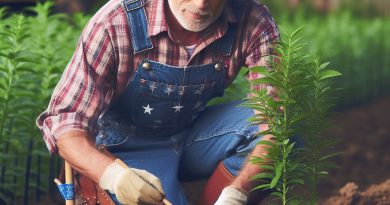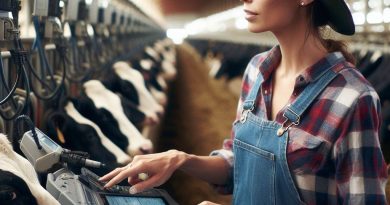Drones in Agriculture: The Future of Farming
Last Updated on January 19, 2024
Introduction
Importance of agriculture in feeding the growing population
Agriculture plays a vital role in sustaining the growing population by providing food for consumption.
Technological advancements have revolutionized various industries, and now it’s impacting agriculture too.
One such technological innovation is the use of drones in agriculture.
Drones are unmanned aerial vehicles that can be equipped with various sensors and cameras to observe and analyze crops.
Advancements in technology and its impact on various industries
Drones have the potential to revolutionize farming by providing valuable data and insights.
These flying machines can quickly cover vast areas of farmland, capturing high-resolution images and identifying crop health 20 quickly.
This information can then be used to detect pest infestations, monitor irrigation needs, and assess soil conditions.
With this real-time data, farmers can take timely actions to optimize crop growth, reduce pesticide usage, and improve overall yields.
Potential benefits and how it could be the future of farming
The benefits of using drones in agriculture are manifold.
Time and cost efficiency are major advantages, as drones can cover large areas in a short time and save human labor.
Additionally, drones enable precision agriculture, allowing farmers to apply fertilizers and pesticides only where necessary, minimizing environmental impact.
Moreover, the data collected by drones can be analyzed to optimize resource allocation and improve farming practices.
Drones in agriculture are not a futuristic concept; they are already being used in various countries around the world.
As technology continues to advance, the potential for drones to revolutionize farming is immense.
With drones becoming more affordable and accessible, farmers of all sizes can benefit from this technology.
The future of farming lies in embracing these autonomous flying machines and harnessing their potential to maximize agricultural productivity while minimizing environmental impact.
Understanding Drones in Agriculture
What drones are and their standard usage
When it comes to agriculture, the implementation of modern technologies has been crucial for enhancing efficiency and productivity.
One such technology that has revolutionized the farming industry is drones.
Drones, also known as unmanned aerial vehicles (UAVs), are autonomous aircraft that can be remotely controlled or fly autonomously.
How drones can be specifically used in agriculture
In the realm of agriculture, drones have found their niche and have become an integral part of farming operations.
These unmanned aerial vehicles offer a plethora of applications and advantages that traditional farming methods lack.
Drones can be equipped with various sensors, cameras, and other sophisticated equipment to perform specific tasks in the agricultural sector.
The versatility of drones in agriculture is truly remarkable.
They can be used to monitor crops, assess crop health, and detect the presence of pests or diseases.
By flying over fields, drones capture high-resolution images and collect valuable data, enabling farmers to make informed decisions regarding crop management.
Moreover, drones can be deployed for precision agriculture, allowing farmers to optimize the use of resources such as water, fertilizers, and pesticides.
They can precisely identify areas that require extra attention, reducing waste and promoting sustainable farming practices.
Furthermore, drones equipped with spraying systems can be utilized for targeted pesticide or fertilizer application, minimizing environmental impact.
The various tasks that drones can perform in farming
The tasks that drones can perform in farming are diverse.
They can be used for aerial seeding, where drones scatter seeds in a controlled manner over large areas of land.
This technique proves to be efficient and cost-effective, especially in regions with difficult terrain or inaccessible areas.
Drones can also conduct inventory management by surveying fields and providing accurate crop counts.
This allows farmers to estimate yields more accurately, plan harvest schedules, and manage logistics accordingly.
Additionally, drones equipped with thermal imaging cameras can identify areas of high temperature, indicating unhealthy or stressed crops needing immediate attention.
Key features and capabilities of agricultural drones
When considering the features and capabilities of agricultural drones, several noteworthy aspects come to light.
Firstly, drones have the ability to cover large areas of land quickly, providing farmers with an extensive aerial view of their crops.
This saves both time and effort compared to traditional scouting methods.
Furthermore, drones are equipped with advanced imaging technologies, including multispectral and hyperspectral cameras, which capture images beyond the visible spectrum.
This enables farmers to assess plant health, detect nutrient deficiencies, or identify early signs of diseases even before they become visible to the naked eye.
Another feature of agricultural drones is their ability to generate precise 3D maps of farmland, which can assist in land surveying and soil analysis.
Farmers can obtain accurate data on soil composition, moisture levels, and topography, aiding in decision-making processes for crop selection and land management.
In general, drones have emerged as a game-changer in the realm of agriculture.
Their wide range of applications and capabilities have transformed conventional farming practices and opened up new possibilities for increasing productivity, sustainability, and profitability.
With the advent of technological advancements, agricultural drones are poised to become an indispensable tool for farmers all over the world.
Read: Revolutionizing Farms: Drones in Crop Monitoring
Benefits of Drones in Agriculture
Using drones in agriculture brings numerous advantages that can revolutionize the future of farming:
Let’s delve deeper into each of these benefits:
Increase in efficiency and productivity
Drones enable farmers to cover larger areas in shorter time frames compared to traditional methods.
Using aerial surveys, farmers can assess their fields regularly, identifying areas that require immediate attention.
Prevention and early detection of diseases and pests
Equipped with high-resolution cameras and sensors, drones can spot signs of diseases or pest infestations early on.
Timely detection helps farmers take appropriate measures to mitigate the spread and minimize crop damage.
Reduced use of pesticides and fertilizers
Drones equipped with precision spraying mechanisms enable targeted application of chemicals.
By delivering pesticides and fertilizers only where needed, farmers can reduce the overall usage, thereby saving costs and reducing the environmental impact.
Cost-effectiveness and resource management
Drones eliminate the need for extensive manual labor required for monitoring and managing large farms.
By automating these tasks, drones can significantly lower operational costs and optimize resource allocation.
Enhanced crop monitoring and data collection
Drones equipped with advanced sensors can gather valuable data on crop health, soil moisture levels, and temperature variations.
This data helps farmers make informed decisions regarding irrigation, crop rotation, and pest control.
Accessibility to remote and difficult-to-reach areas
Drones excel in accessing areas that are challenging for humans and traditional machinery.
This accessibility allows farmers to effectively monitor and manage geographically diverse regions without incurring additional costs.
In essence, the advantages of using drones in agriculture are substantial.
Drones enhance efficiency, improve disease and pest management, reduce chemical usage, optimize resource allocation, enable precise monitoring, and provide accessibility to remote areas.
Embracing this technology in farming practices promises a future of increased productivity, sustainability, and overall growth in the agricultural industry.
Read: Drones in Agri: Irrigation Game Changer
Applications of Drones in Agriculture
In recent years, drones have emerged as a valuable tool in the agriculture industry.
Their ability to perform various tasks with precision and efficiency has revolutionized farming practices.
Let’s explore some of the key applications of drones in agriculture:
- Crop monitoring and management: Drones equipped with advanced imaging sensors and cameras can capture high-resolution images and collect data about crop health, growth, and yield.
- Precision agriculture and variable rate application: Drones enable farmers to apply precise amounts of fertilizers, pesticides, and other inputs to specific areas of the field, improving resource management and reducing costs.
- Soil and field analysis: Drones can quickly assess soil conditions, measure nutrient levels, and identify areas prone to erosion or other soil-related issues.
- Irrigation and drainage management: Drones equipped with thermal cameras can detect variations in soil moisture and help farmers optimize irrigation and drainage systems accordingly.
- Livestock and herd monitoring: Drones equipped with thermal or infrared cameras can count livestock, track their movement, and identify any signs of illness or distress.
- Crop spraying and dusting: Drones can efficiently apply pesticides, herbicides, or fertilizers to crops, ensuring even coverage and reducing the risk of human exposure.
- Planting and seeding: Drones equipped with precision seeding mechanisms can accurately plant seeds, ensuring optimal seed spacing and reducing manual labor.
- Crop health assessment and disease detection: Drones can capture multispectral images of crops, allowing farmers to detect early signs of diseases, nutrient deficiencies, or other stress factors.
Advantages of Drones to farmers
These applications offer numerous advantages to farmers and contribute to sustainable agriculture practices:
- Drones provide real-time information, allowing farmers to make timely decisions about crop management.
- They offer cost-effective solutions by optimizing the use of resources such as fertilizers, water, and pesticides.
- By reducing the need for manual labor, drones save time and reduce physical strain on farmers.
- They enable farmers to achieve higher crop yields and improve the overall quality of produce.
- Drones can access difficult-to-reach areas, such as steep terrains or large fields, which may be challenging for traditional machinery or humans.
- By facilitating precise applications of inputs, drones contribute to reducing environmental impact and minimizing chemical residues in food products.
- They help in early detection of plant diseases or pest infestations, enabling farmers to take immediate action and prevent extensive damage.
While the potential of drones in agriculture is evident, there are still challenges to overcome, such as regulations, privacy concerns, and the initial investment required.
However, with advancements in technology and increasing awareness about their benefits, drones are poised to play a significant role in the future of farming.
Read: Agri-Drones: Changing the Face of Farming

Challenges and Limitations of Drones in Agriculture
While drones have the potential to revolutionize farming practices, several challenges and limitations need to be addressed for their widespread adoption in agriculture.
These challenges include:
Regulatory restrictions and compliance issues
The use of drones in agriculture is subject to various regulatory restrictions imposed by aviation authorities.
Compliance with these regulations can be time-consuming and expensive for farmers.
Initial costs and investment
Adopting drone technology in agriculture requires a significant upfront investment, including the purchase of drones, sensors, and other necessary equipment.
These costs can be prohibitive for small-scale farmers.
Integration with existing farm systems and practices
Incorporating drones into existing farm systems and practices can be challenging.
Farmers may need to modify their infrastructure and workflows to accommodate the use of drones effectively.
Training and skill requirements for operating drones
Farmers and workers need proper training and certification to operate drones safely and efficiently.
Acquiring the necessary skills can be time-consuming and may require additional resources.
Battery life and flight duration limitations
Most agricultural drone models have limited battery life and flight durations, which restrict their operational efficiency.
Frequent battery changes and recharging can interrupt farming operations.
Weather conditions and environmental factors
Drones are sensitive to adverse weather conditions, such as strong winds, heavy rain, or extreme temperatures.
Unfavorable weather can restrict their usability and pose safety risks.
Privacy and data security concerns
The use of drones in agriculture involves collecting and analyzing vast amounts of data.
Farmers need to address concerns related to privacy, data ownership, and data security to ensure the responsible use of drone technology.
Despite these challenges, advancements in drone technology and ongoing research aim to overcome these limitations and make drones more accessible and practical for agriculture.
In a nutshell, while drones offer significant potential in revolutionizing agriculture, their widespread adoption faces various challenges and limitations.
Regulatory compliance, initial costs, integration with existing practices, skill requirements, battery limitations, weather conditions, and data security concerns are among the critical factors that need to be addressed.
Overcoming these challenges will pave the way for the future of farming, where drones play a central role in enhancing productivity and sustainability in agriculture.
Read: Sky-High Agri Tech: Drone Spraying Explained
Case Studies and Success Stories
Case studies from different farm types and regions
Drones are already transforming farms worldwide, as evidenced by these real-world examples.
A family rice farm in China uses drones to create detailed maps of their fields.
This enables tailored water and fertilizer application, saving 15% on inputs.
In Brazil, a passionfruit plantation’s drones detect fungal infections early, allowing prompt treatment to avoid large crop losses.
An Armenian vineyard combines thermal drone imagery with AI to predict harvests weeks in advance.
Large operations also demonstrate drones’ potential. In the US Midwest, an agricultural corporation’s drones scout 200,000 acres of farmland daily to identify issues needing attention.
This has led to 10% higher crop yields.
A banana plantation in South America uses drones to assess storm damage across 5000 acres within hours.
Rapid response reduces spoilage and saves an estimated $200,000 annually.
Positive outcomes, lessons learned, and measurable benefits
Positive outcomes include reduced costs, limited crop losses, higher yields, and improved sustainability.
Users report drones providing invaluable aerial visibility of their fields.
The regular data enables issues to be caught early when treatment is most effective.
Drone insights allow farmers to take timely, targeted action.
As prices fall and technology improves, drones are viable for farms of all types worldwide.
When farmers integrate drones into their regular practices, the benefits become clear.
Drones provide the data to farm smarter and maximize both productivity and resource efficiency.
Adoption will continue rising rapidly as drones prove themselves indispensable tools for modern agriculture.
Future Outlook and Potential Developments
Advancements in drone technology specific to agriculture
Drones will continue advancing to meet farming’s needs.
Developers are creating drones optimized for agricultural tasks.
Features like multispectral cameras, swappable payloads, and weather resistance suit drones to fieldwork.
Battery life and range will improve for longer, farther flights. Prices are decreasing as drones become mainstream.
User-friendly software will enable intuitive control and data analysis.
Integration with other emerging technologies
AI-enabled drones will automate scanning and identify crop issues autonomously.
Drones will integrate with other emerging tech.
Machine learning algorithms will process drone data to derive actionable insights.
Robotic systems will use drone scouting to selectively apply inputs.
Drones with robotic arms could plant seeds or spray crops.
GPS-guided tractors can incorporate drone data on soil conditions.
This tech convergence will amplify drones’ value.
Adoption and acceptance by farmers and industry experts
Adoption is rising as farmers witness benefits firsthand.
Industry groups promote best practices for drone integration. Insurers may offer discounts to farmers leveraging drones.
As platforms become standardized, using drones for farming may equal using computers for accounting.
Drones will supplement but not replace ag workers.
Drones are tools to enhance human ability and knowledge.
Staff roles may shift from scouting to data analysis.
Drones may also attract youth to agriculture. Looking ahead, drones will be integral to farms.
They will empower data-driven crop management for maximum production.
Drone adoption will spread until ubiquitous.
For farmers, utilizing drones will become routine as this technology transforms modern agriculture.
Conclusion
As we conclude our discussion on drones in agriculture, it is evident that these unmanned aerial vehicles have immense potential in revolutionizing the farming sector.
Throughout our exploration, we have discovered the importance of drones in optimizing crop management, improving yields, and reducing costs.
Farmers stand to benefit greatly from the various positive impacts that drone technology brings.
They can gather real-time data, monitor crop health, identify areas of concern, and quickly respond to potential issues.
The efficiency and accuracy offered by drones significantly enhance decision-making processes and ultimately lead to better farm productivity.
Moreover, by reducing the need for labor-intensive tasks, drones can save farmers both time and money.
As we look ahead, it is crucial to emphasize the need for further research, development, and adoption of drone technology in farming.
Continued advancements in this field will unlock even more potential, leading to greater benefits for the agriculture industry.
The transformative role of drones in shaping the future of agriculture cannot be overstated.
We foresee a future where drones are an integral part of every farmer’s toolkit, optimizing operations and cultivating sustainable practices.
It is an exciting time for agriculture, and the possibilities are endless. Let us embrace this technology and unlock its full potential for all.


